
The Fantastical Machines of Wayne Martin Belger
Photo Technique, September/October 2012
By Robert Hirsch
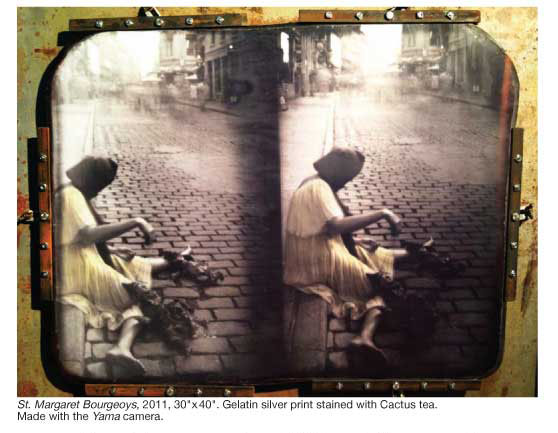
Enter into a darkroom and make a small round hole in the window shade that looks out onto a bright outside scene. Hold a piece of translucent paper 6-12 inches from the hole and you will see what is outside the window. This optical phenomenon, which has been known since ancient times, provides the basis for making pinhole (camera) photographs. Wayne Martin Belger’s philosophical approach to his subjects utilizes this phenomenon to build fantastical handmade pinhole cameras, which he then operates to create his images.
Robert Hirsch: How did you get involved in photography?
Wayne Martin Belger: In the mid-1990s a good friend, who is an automotive photographer, was working with a flimsy pinhole camera so I made him one out of aircraft aluminum and stainless steel. And because all the tools I make are extensions of myself, it also had insects crawling out of keyholes and a Pablo Neruda poem embossed on top. I took it out for a test and fell in love with the process.
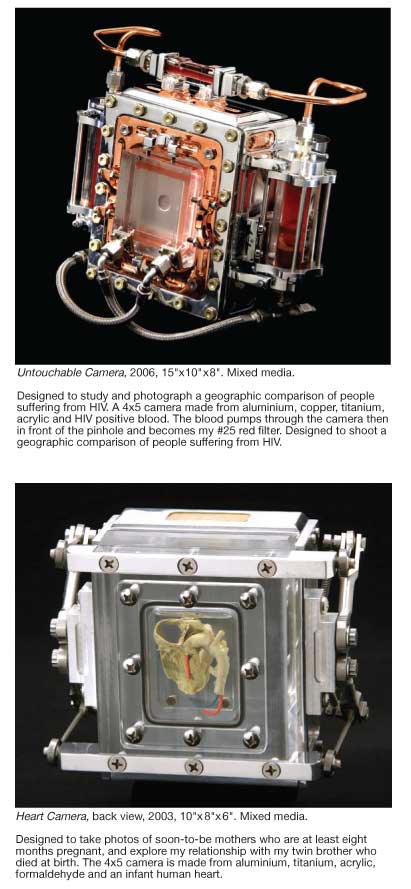 RH: What key life event has influenced your outlook? RH: What key life event has influenced your outlook?
WMB: Growing up I loved being a twin. The problem was I didn’t have a twin. In my 20s, I had a series of bizarre accidents, which led my family to get me a reading from a Santeria Priest. He told me my twin brother was trying to bring me into his world because twins are one. I informed my mom about my evil twin and she told me I was a twin, but I was the only live birth. The priest then did a ceremony to put my twin to rest, after which my strange accidents stopped. But so did a view or feeling about the world that had been a part of my everyday world. However, this experience opened me up to a deeper sense of life’s possibilities− that going down the rabbit hole of your personal quest for adventure into the unknown never really ends.
RH: How has religion affected the way you work?
WMB: When I was a child the Catholic Mass was in Latin. I had no idea what was going on, so I relied on visual input for the communications. The priest would have gold and silver objects designed to provide a link between himself, his audience and his subject: Christ. Without knowing it, I was doing the same thing in my work. I have always made altars—shrines that are tools I employ to commune with a desired subject. The cameras I make do the same thing.
RH: How would you describe what you do?
WMB: I make subject-specific cameras and installa- tions, which are produced for and from the subject I wish to be in communion with.
RH: What other factors have informed your work?
WMB: I have a fascination with duality, such as physicist J. Robert Oppenheimer’s love for Sanskrit and Hin- duism while creating the Atomic bomb, which brought out both his pacifistic and murderous natures. My study of this yin/yang balance comes from my interest in what motivates people to build “us vs. them” walls that disturb this perfect union. Also, my environment plays a vital role. I live in Tucson, AZ, on 94 acres of open saguaro forest, in a 100-year-old stone house with no TV, video games, or Internet. Without the static of daily life it’s easier to access your passions.
RH: Why the desire to physically interact with your subjects?
WMB: I prefer an experiential path to learning. I am a book fanatic. Growing up I would take the information from books, and then go and experience what I was reading. Each project is made for and from a subject I wish to learn about, and the camera is made from a combination of my personal history and that of my subject’s. Making photographs with one of my hand-made cameras is an intimate experience between my subject and myself, giving me a direct learning experience. I was never trained as a photographer, so I made up my own process of being involved with my subjects. I don’t think I would be able to learn what I want to learn if I just stood back and took photographs from a distance. In life, I do not want to be a voyeur.
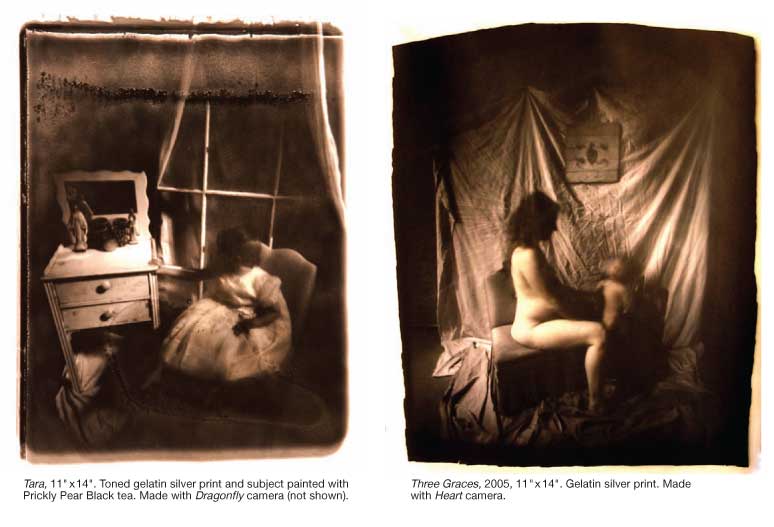
RH: Why pinhole cameras?
WMB: I have a passion for physics, history and the alchemy of metal. The pinhole camera creates a pure representation of history by altering metal with unaltered light and time. It is a perfect blend of the things I love.
RH: How does building your own camera act as a portal to your subject?
WMB: I see building a camera as a bridge to what I want to learn about. Just as a priest made his tools of gold and silver and Blood and Body to be in direct relationship with the subject Jesus, I create my tools of aluminum, titanium, blood and body to be in direct relationship with the subjects they are created for.
RH: Describe your camera constructions.
WMB: Camera construction starts with a study of my subject. The artifacts I have collected from the subject provide the main “feel” of the camera. I don’t do any drawings; I make the camera in my head and then mill out the parts from aircraft aluminum plate.
RH: Describe your working methods—what you do and how you do it.
WMB: I start with a spark of something I want to learn about or be involved with. Next, I collect artifacts that connect me with the subject. Then I start constructing the camera, which can take from months to a year or two. By the time the camera is ready, my subject and I have had time to get to know each other and the shooting sessions become a great release and learning experience.
RH: How do you light and expose your images?
WMB: Most of my lighting is natural. Exposure time start at one or two seconds and extend from there. For instance, I made an hour-and-a-half pinhole exposure at 105 feet underwater on 4x5-inch Kodak 160 VC film. It took five hours, two tanks of air and a case of nitrogen narcosis to make one photograph.
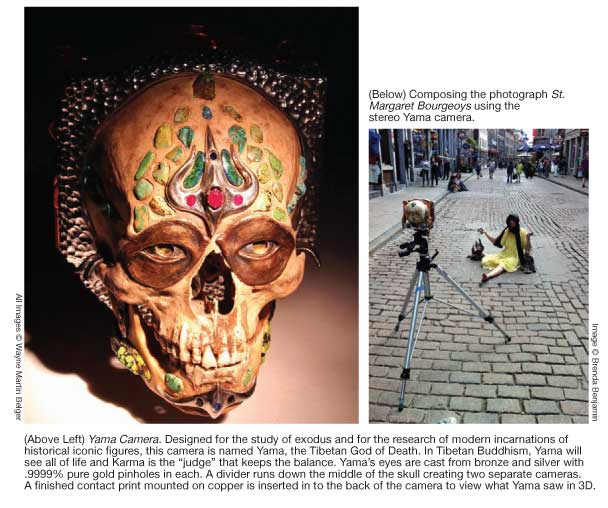
RH: How did you learn these methods?
WMB: Self-discovery has played an important role in my life. One of the strongest paths for self-discovery is trial and error. I like the benefits of being self-taught because you learn techniques you might have never thought of otherwise.
RH: What concepts influence your work?
WMB: My work is a combination of art, science, religion and mythology. I think it is a perfect time to create a visual experience that embodies and complements each of these conceptions.
RH: What is important to consider when making im- ages?
WMB: I get to know my subject so we feel comfortable before a shoot. Also, because my cameras do not look like traditional cameras, the stress of being in front of a camera isn’t there either. These factors help me get to the essence of what I wish to learn about my subject, whether it is a person living with HIV or a mother about to give birth.
Editor’s Note: You can view more of Wayne Martin Belger’s images at boyofblue.com
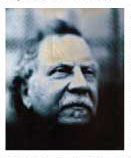
Robert Hirsch’s latest book, Light and Lens: Photography in the Digital Age, Second Edition, has just published by Focal Press. Hirsch is author of Exploring Color Photography: From Film to Pixels; Photographic Possibilities: The Expressive Use of Equipment, Ideas, Materials and Processes; and Seizing the Light: A Social History of Photography.
He heads Light Research, a consulting service that provides professional services to the fields of photographic art and
education. For details about his visual and written projects visit: www.lightresearch.net. Article ©Robert Hirsch 2012.
|